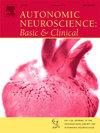帕金森病患者在肌肉代谢反射激活开始时心脏迷走神经再激活不会进一步受损
IF 3.3
4区 医学
Q2 NEUROSCIENCES
引用次数: 0
摘要
帕金森病(PD)是一种常见的神经退行性疾病,以非运动症状和显著的交感和副交感神经活动改变为特征。然而,目前尚不清楚的是,在运动停止后和孤立性运动后缺血(PEI)发生时,不适当的自主神经调节是否在快速副交感神经调节中表现出来。在此,我们验证了这样一个假设,即与老年和年轻男性相比,PD患者在运动停止时由于心脏迷走神经再激活受损而表现出心率(HR)恢复减慢。研究对象为11例PD患者(66±9岁),9例年龄匹配的对照组(64±7岁)和10例年轻对照组(21±1岁)。所有参与者在40%的最大自主收缩时进行90秒的等距握力,然后进行3分钟的PEI。连续记录HR(心电图)。HR恢复被定义为运动结束时与PEI前30秒结束时HR的差异。对恢复后30秒内的心率变异性(HRV)进行量化。停止运动后,PD组和年龄匹配组的心率恢复明显低于年轻组(Δ-10±5 vs. Δ-14±6 vs. Δ-26±8)。Min−1,30s;P & lt;0.001;分别)。与对照组相比。与年轻对照组相比,帕金森病患者和年龄匹配的对照组运动后HRV增加较少。总之,PD患者和年龄匹配的对照组表现出迟钝的副交感神经再激活。然而,与我们的假设相反,与年龄匹配的对照组相比,PD患者在HR恢复方面没有表现出进一步的衰减,这表明PD不会加剧迷走神经再激活损伤,而不仅仅是与衰老相关的损伤。本文章由计算机程序翻译,如有差异,请以英文原文为准。
Cardiac vagal reactivation at the onset of muscle Metaboreflex activation is not further impaired in patients with Parkinson's disease
Parkinson's disease (PD) is a common neurodegenerative disorder characterized by non-motor symptoms and marked altered sympathetic and parasympathetic activity. However, it is currently unclear if inappropriate autonomic adjustments are manifested during rapid parasympathetic adjustments that occur following cessation of exercise and at the onset of isolated post-exercise ischemia (PEI). Herein, we tested the hypothesis that, compared to older and young men, PD patients would show attenuated heart rate (HR) recovery at exercise cessation due to impaired cardiac vagal reactivation. Eleven PD patients (66 ± 9 yr), 9 age-matched controls (64 ± 7 yr), and 10 young controls (21 ± 1 yr) were studied. All participants performed 90-s of isometric handgrip at 40 % of maximal voluntary contraction, followed by 3-min of PEI. HR (electrocardiography) was continuously recorded. HR recovery was defined as the difference between HR at the end of the exercise and at the end of the first 30-s of PEI. HR variability (HRV) during the first 30-s of recovery was quantified. Following the cessation of exercise, the HR recovery was significantly lower in PD and age-matched controls compared to young controls (Δ-10 ± 5 vs. Δ-14 ± 6 vs. Δ-26 ± 8 beats.min − 1 at 30s; P < 0.001; respectively). compared to controls. HRV increased less post-exercise in PD and age-matched controls compared to young controls. In summary, PD patients and age-matched controls demonstrate blunted parasympathetic reactivation. However, contrary to our hypothesis, PD patients did not exhibit further attenuation in HR recovery compared to age-matched controls, suggesting that PD does not exacerbate vagal reactivation impairments beyond those associated with aging.
求助全文
通过发布文献求助,成功后即可免费获取论文全文。
去求助
来源期刊
CiteScore
5.80
自引率
7.40%
发文量
83
审稿时长
66 days
期刊介绍:
This is an international journal with broad coverage of all aspects of the autonomic nervous system in man and animals. The main areas of interest include the innervation of blood vessels and viscera, autonomic ganglia, efferent and afferent autonomic pathways, and autonomic nuclei and pathways in the central nervous system.
The Editors will consider papers that deal with any aspect of the autonomic nervous system, including structure, physiology, pharmacology, biochemistry, development, evolution, ageing, behavioural aspects, integrative role and influence on emotional and physical states of the body. Interdisciplinary studies will be encouraged. Studies dealing with human pathology will be also welcome.

 求助内容:
求助内容: 应助结果提醒方式:
应助结果提醒方式:


